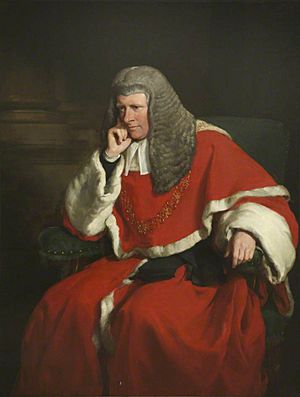William Erle facts for kids
Sir William Erle (born October 1, 1793 – died January 28, 1880) was an important English lawyer, judge, and Whig politician. He was known for his strong sense of fairness and his work in shaping laws, especially those related to trade unions.
Contents
Early Life and Education
William Erle was born in a village called Fifehead Magdalen in Dorset, England. His father was Reverend Christopher Erle. William went to Winchester College, a famous school, and then studied at New College, Oxford University. He earned a degree in law in 1818.
After finishing his studies, he became a lawyer in 1819. He worked on cases in the western part of England. He became known for being very thorough and careful in his work, which helped him gain a good reputation.
In 1834, William Erle married Amelia Williams. Around the same time, he became a senior lawyer, which is called "taking silk."
Political Career
From 1837 to 1841, William Erle was a member of the British Parliament for the City of Oxford. Even though he was a politician, he didn't speak much in Parliament. He consistently voted with his political party, the Whigs. In 1844, he became a lawyer for the Bank of England and decided not to run for Parliament again.
Becoming a Judge
In 1845, William Erle was appointed as a judge in the Court of Common Pleas. He was also knighted, which meant he was given the title "Sir." The next year, he moved to another important court called the Queen's Bench.
In 1859, Sir William Erle returned to the Court of Common Pleas as its Chief Justice. This was a very high position. At the same time, he became a member of the Privy Council, a group of important advisors to the Queen.
His Work as a Judge
Sir William Erle was seen as a "strong" judge. This meant he was very good at quickly understanding the important facts of a case and making clear decisions about the law. He always tried to be fair and unbiased, but he was also very firm in his own opinions. People described his way of speaking as calm and steady.
He handled many important cases, especially those about contract law, which deals with agreements between people. One famous case he decided was Kennedy v. Broun (1863). In this case, he ruled that lawyers could not have a special contract for payment based on the outcome of a case.
Sir William Erle was also part of the Trades Union Commission of 1867. This group looked into the laws about trades unions, which are organizations that protect workers' rights. He wrote a clear explanation of the laws at that time. His ideas helped influence Parliament, leading to the Trade Union Act 1871. This act was important because it gave more legal rights to trade unions.
He retired from his role as a judge in 1866. He received a lot of praise for how well and fairly he had done his job.
Private Life
After retiring, Sir William Erle mostly lived at his home called Bramshott, near Liphook, in Hampshire. He was interested in local community matters. Even though he wasn't a big fan of sports, he loved horses, dogs, and cattle. He was described as looking like a typical country gentleman, with a healthy complexion and bright eyes.
In 1851, he had a Celtic cross built on Gibbet Hill, Hindhead. This cross was placed where a public gibbet (a structure used for hanging criminals) once stood. He did this to help local residents feel safer and less fearful of the spot. Sir William Erle passed away at his estate in Bramshott. He did not have any children.
Honours
- Doctor of Civil Law, University of Oxford (1857)
- Fellow of the Royal Society (1860)
- Honorary Fellow, New College, Oxford



